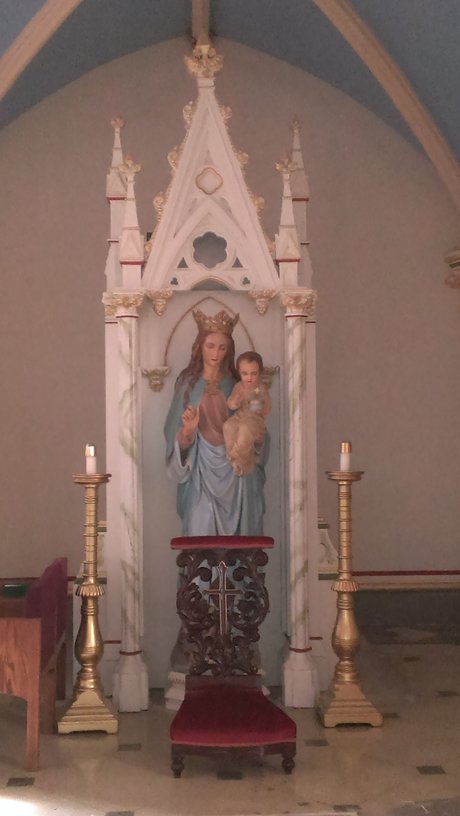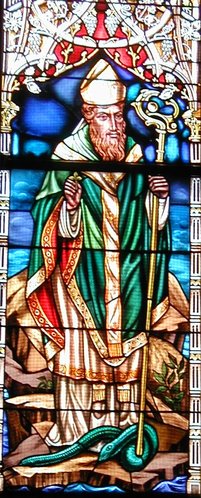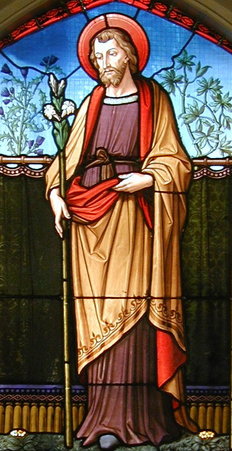St. Joseph Cathedral Renovated to Original Beauty in New Hampshire
Restored Church Reminds New England to Seek Heavenly Aid

JOSEPH’S CHURCH. St. Joseph Cathedral offers devotion to the foster father of Jesus, Mary and St. Patrick. Sanctuary, Gerald Durette Photography; statue, Colleen Byrne Lang; windows, Deacon Robert Potvin
St. Joseph Cathedral in Manchester, N.H., consecrated in April 1894, is seeing its beauty restored, thanks in great part to its original architect, Patrick Charles Keely. In essence, it’s a story of two Keely churches — or Keely restoring Keely.
There’s no doubt that Keely can be called the “Father of Catholic Church Architecture” in this country. After emigrating from Ireland, he designed well over 600 churches and 26 cathedrals during the 19th century, many in major cities.
His churches range from Halifax and Montreal, Canada, to Baton Rouge, La., and from the East Coast to the Midwest. The Northeast and Southeast abound with Keely churches. It was a prodigious feat, a phenomenal output of outstanding churches that left a monumental mark on Catholic worship.
Among them is St. Joseph Cathedral (StJosephCathedralNH.org), originally designed as a parish church by Keely in 1867, named a cathedral in 1884 and then expanded in the early 1890s to accommodate the growing diocese.
Once 1969 rolled in, a renovation misinterpreting Vatican II became a “wreckovation.” The elaborate marble reredos and altar were destroyed, the Stations of the Cross removed, and the cathedral painted beige.
But then came 2014: The lighting was deemed a fire hazard.
“Providentially, in Boston, Holy Cross Cathedral had taken over Holy Trinity Church, which was closed in 2008. The rector of the cathedral was in touch with us here, knowing we, too, were a Keely church, as well as Holy Trinity and Holy Cross,” explained Msgr. Anthony Frontiero, St. Joseph’s rector. He was told Holy Trinity was going to be sold and asked if he wanted anything from it.
He certainly did, beginning with the reredos and the Stations of the Cross in the lower church.
“My feeling was this reredos was a timeless appointment in a cathedral church,” he told the Register. “Some were concerned we were turning back the clock in this project, but these items are timeless, and they go with the architecture of the church.”
Reredos and Altar
What a treasure Holy Trinity provided (HolyTrinityGerman.org). The finely intricate reredos has highly detailed classic elements in the Keely masterpiece manner. It rises in ornate Gothic spires, whose fine, lace-like details are in the delicate wedding-cake style.
The two end spires rise high to become shrines honoring the Sacred Heart of Jesus and the Immaculate Heart of Mary. Their statues are carved so that they look as if they are gazing toward the tabernacle and altar below. With this tabernacle within the reredos, the Blessed Sacrament is once again at the center of the sanctuary.
Six small spires that form a line between these large spires act as shrines for six gold seraphim, ready to sing the Divine Praises. Msgr. Frontiero called this wooden faux-marble altar “magnificent — more beautiful than the original reredos that was here.”
Holy Trinity’s parishioners from early decades would be grateful their magnificent reredos has been restored to use. Surely parishioner Louis Prang also knew this reredos, altar and the Stations of the Cross. A German immigrant, he received the title “Father of the American Christmas Card” because he “invented” such cards and the custom of sending them.
The Von Trapp family of Sound of Music fame also probably knew these beautiful elements. As friends of Holy Trinity’s pastor, Jesuit Father Francis Weiser, they sang at Holy Trinity at times, including the church’s Centennial Anniversary Mass in 1944.
Surrounding this reredos and altar of sacrifice, the rest of the newly re-plastered and redecorated sanctuary supports and enhances the liturgical and architectural beauty. The ceiling of the apse is like an azure sky opening to heaven. The rosettes decorating the gothic ribs — a standard Keely signature — accentuate the blue in their burgundy with gold, while gold flows along the wide moldings, too.
Side altars from Holy Trinity are now worked into new arched side shrines off the sanctuary. These statues are originals from Germany — one honoring Mary and one honoring Joseph.

The cathedral’s columns also enhance the beauty in their new faux-marble finish, while the new chandeliers are “specifically made to recapture the original architecture,” Msgr. Frontiero noted.
The Stations of the Cross are works of great artistry. They are from the lower Holy Trinity Church and commanding in size, being six feet tall and three feet wide. In heavy wooden frames and weighing 300 pounds each, they are beautifully carved in bas relief and restored in multicolor. One change was made: Their German text was redone in English.
Superior Stained Glass
When St. Joseph Cathedral was expanded from 1892 to 1894, the original stained-glass windows were replaced by the current ones, which are like masterpieces from the Vatican Museums. They grace the church as heavenly realities in a symphony of color and design.
From the best glass artists of the time, they seem to have been waiting for this restoration, since they were made in Innsbruck, Austria, by Tiroler Glasmalerei und Mosaik Anstalt (Tyrol Art Glass Co.). Along with the Franz Mayer and F.X. Zettler studios in Munich, this company formed the triumvirate of the best stained-glass makers in liturgical arts, equivalent to the finest of Renaissance masters. In fact, they often worked together.
The windows are like a “mini Bible,” with awe-inspiring progression from creation through New Testament events, presented in tri-part scenes with magnificent, colorful beauty. The windows rise in Gothic-like spires with the main scene in the center. Beneath them, ornate designs form a large base. Above them, an angel adds a heavenly presence.
Visitors can follow several mysteries of the Rosary, from the Annunciation to the Resurrection and the Coronation of Mary. One can meditate on Jesus the Good Shepherd, Jesus the Teacher, John the Baptist referring to Jesus or Jesus’ first public miracle at the Wedding at Cana, as well as the Blessed Mother receiving Communion from St. John and a very moving scene with Mary gazing lovingly at Joseph and Jesus, who are deep in conversation.
And the great saints of March, St. Joseph and St. Patrick, can be seen in adjacent windows — they are co-patrons of the Manchester Diocese. St. Joseph’s window reminds viewers, Ite Ad Joseph — “Go to Joseph.”


A video called “Meditations in Light” on both the cathedral website and YouTube gives an idea of the beauty of these windows, which are in the cathedral’s Chapel of the Blessed Sacrament, part of the 1892 expansion. The chapel is said to look much as it did originally, including restoration of the original stenciling when samples of it were found under the subsequent painting.
Moving Reactions
With everything blending like a melodious song and the interior appointments once again in grand Keely design, the cathedral’s overseers are eager to finish the nave.
“It has been quite a transformation and only happened because we were given the reredos and the stations,” Msgr. Frontiero said. “We were so grateful to the people of Holy Trinity.”
Some of Holy Trinity’s former parishioners have come for Sunday Mass, including one German-Jesuit priest who served at Holy Trinity.
“They were moved to tears,” St. Joseph’s rector said. “It looks like a cathedral again.”
Joseph Pronechen is a
Register staff writer.
- Keywords:
- March 6-19, 2016

















